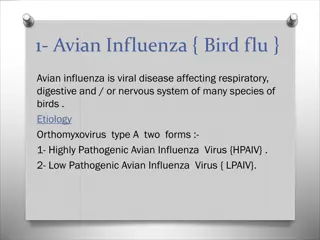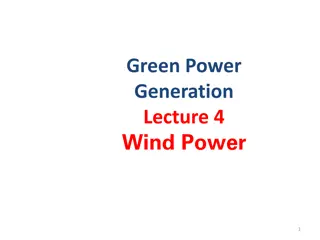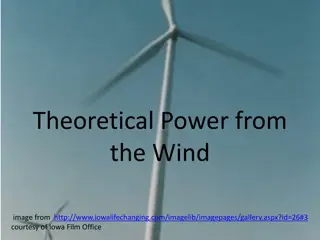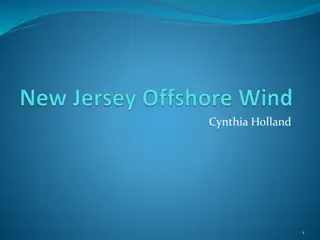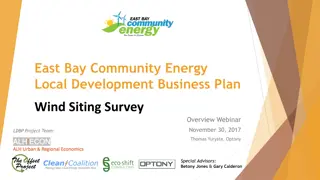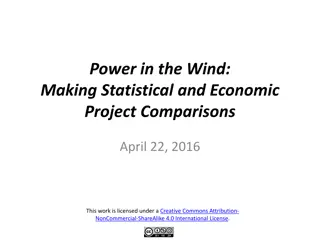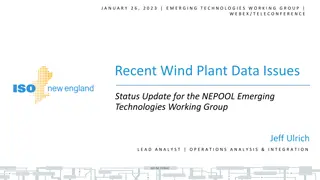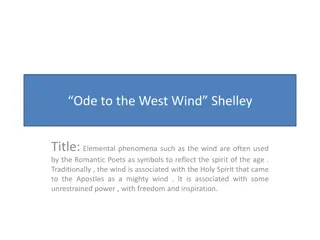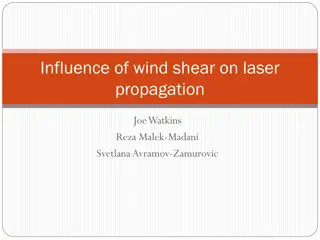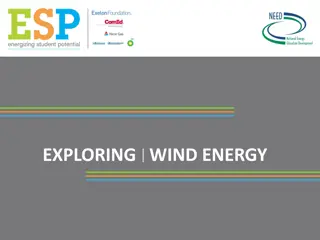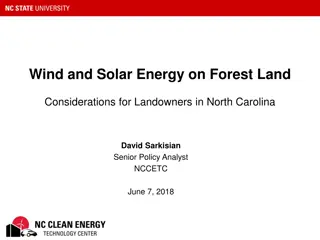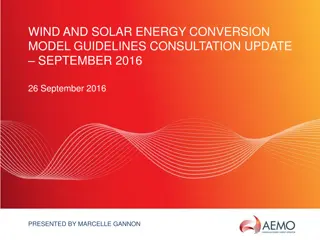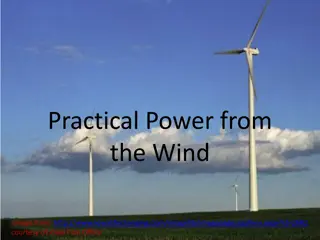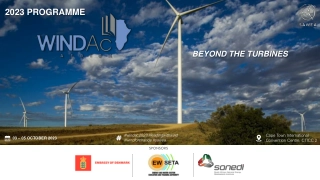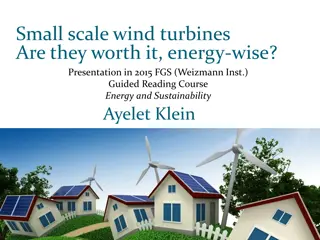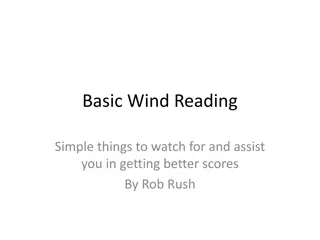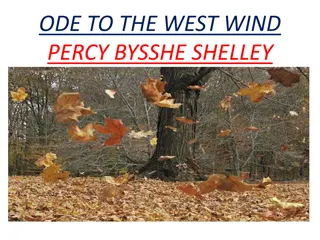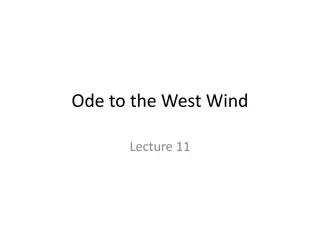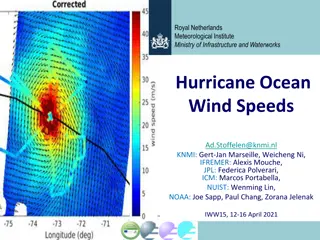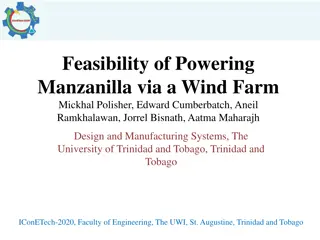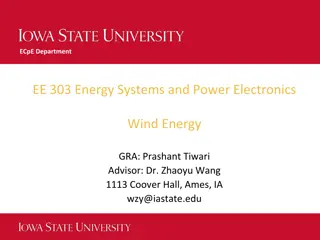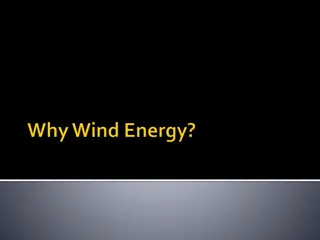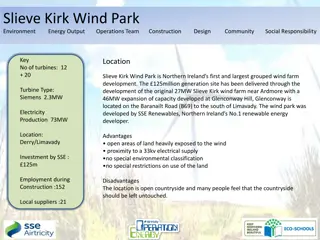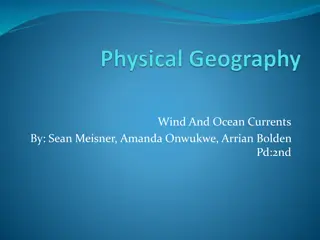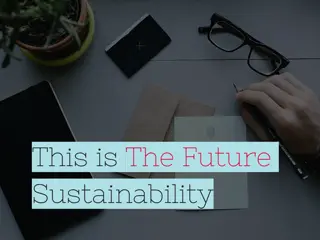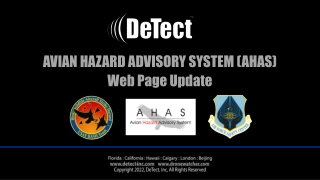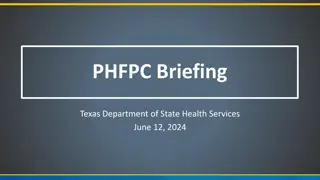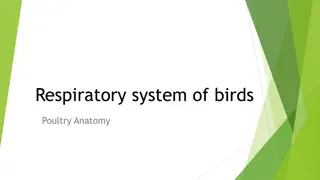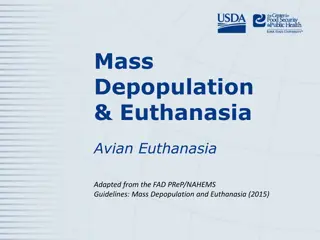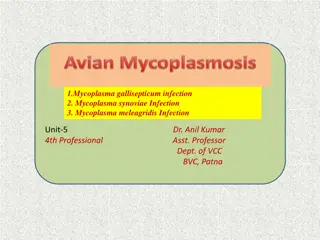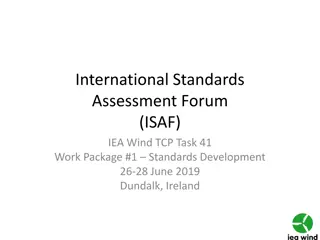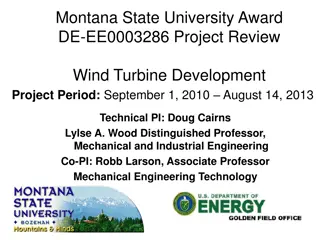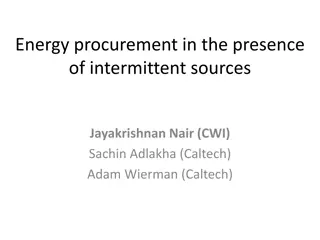Avian Interactions with Wind Energy Development
The slides discuss avian interactions with wind energy development, highlighting challenges faced by bird species due to climate change. Strategies to minimize these interactions are explored, emphasizing the environmental benefits of wind energy and comparing avian fatality rates with other engineered structures.
- Avian interactions
- Wind energy development
- Environmental benefits
- Climate change
- Mitigation strategies
Download Presentation

Please find below an Image/Link to download the presentation.
The content on the website is provided AS IS for your information and personal use only. It may not be sold, licensed, or shared on other websites without obtaining consent from the author. Download presentation by click this link. If you encounter any issues during the download, it is possible that the publisher has removed the file from their server.
E N D
Presentation Transcript
The following slides provide information about avian interactions with wind energy development and the strategies that help to minimize and mitigate these interactions. Bald eagle. Photo by Dennis Schroeder, NREL 35743 Wind Energy & Avian Species: 1
Many avian species face challenges related to climate change. The National Audubon Society s Birds and Climate Change Report determined that by 2050, 126 bird species will lose more than 50% of their current habitat ranges in some cases up to 100% with no possibility of moving elsewhere if rising temperatures continue on their current path.* We can dramatically reduce water and climate risks by choosing options such as renewable energy.** *National Audubon Society. 2014. Birds and Climate Change Report. ** Union of Concerned Scientists. 2013. Water-Smart Power: Strengthening the U.S. Electricity System in a Warming World. Golden eagle. Photo by John De La Rosa, NREL 35801 Wind Energy & Avian Species: 2
Wind energy provides multiple environmental benefits for people and wildlife, and it can also impact certain avian species. Environmental benefits include: Reduced greenhouse gas emissions Reduced water usage No water pollution Limited waste High land use compatibility. Two types of impacts to birds are of most concern: Direct mortality from collisions Indirect impacts, such as the animal s avoidance of an area or through habitat degradation, loss, abandonment, or fragmentation.* Piping plover. Photo from Victoria Lima, USFWS Northeast Region Flickr Pine warbler. Photo from Frank Miles, USFWS Northeast Region Flickr *National Renewable Energy Laboratory. 2010. National Wind Technology Center: Environment and Siting Fact Sheet. Wind Energy & Avian Species: 3
Fatality rates related to wind energy projects are less than those attributed to other engineered structures. Although this number is expected to increase as wind energy expands, comparing wind-related avian fatality rates to those attributed to collisions with other engineered structures provides perspective that is important to understanding wind energy s impact on avian species. Structure Average Fatality Rates (Million Birds/Year) Wind turbines 0.2* Communications and other towers 6.8** Buildings 300-1,000*** *Loss, S.R.; Will, T.; Marra, P. December 2013. Estimates of bird collision mortality at wind facilities in the contiguous United States. Biological Conservation. **Longcore, et al. February 2013. Avian mortality at communication towers in the United States and Canada: which species, how many, and where? Biological Conservation. ***Loss, et al. October 2013. Bird building collisions in the United States: Estimates of annual mortality and species vulnerability. The Condor. Wind Energy & Avian Species: 4
Some U.S. wind developments average between three and five bird fatalities per megawatt per year.* Songbirds account for nearly 60% of these bird collision fatalities, and it is important to understand that these fatalities represent a minor percentage of total population size, even for species that are impacted most frequently.** The highest reported total is 14 bird fatalities per megawatt per year.** Red-naped sapsucker. Photo by Tom Koerner/USFWS Mountain-Prairie Flickr *Erickson, et al. September 2014. A Comprehensive Analysis of Small-Passerine Fatalities from Collision with Turbines at Wind Energy Facilities. PLoS ONE. **Strickland, et al. 2011. Comprehensive Guide to Studying Wind Energy/Wildlife Interaction. National Wind Coordinating Collaborative. Wind Energy & Avian Species: 5
Project developers should identify and avoid locations with favorable habitat characteristics to limit potential negative impacts to sensitive species. These can include areas with: Low-level flight paths* High prey density Maternity roosts Staging areas Winter ranges Nesting sites Migration stopovers or corridors Wetlands.** Bear River Refuge. Photo from Jerry Whetstone/USFWS Mountain Prairie Flickr *Gartman, et al. August 2016. Mitigation Measures for Wildlife in Wind Energy Development, Consolidating the State of Knowledge Part 1: Planning and Siting, Construction. Journal of Environmental Assessment Policy and Management. **U.S. Fish and Wildlife Service. 2012. U.S. Fish and Wildlife Service Land-Based Wind Energy Guidelines. Wind Energy & Avian Species: 6
Depending on location, the risk of impact from wind energy development on eagle populations is low. On a geographical basis, the risk to eagle populations from wind energy development varies because large areas of the United States rarely experience any eagle interactions.* The Journal of Raptor Research reported that in the past 20 years, there have been ~79 golden eagle fatalities and six bald eagle fatalities at wind power plants other than Altamont, California.** Based on the best available data from the U.S. Fish & Wildlife Service, the leading anthropogenic causes of eagle fatalities are poisoning and shooting.*** Bald eagle. Photo by Lee Jay Fingersh, NREL 35708 *Good, R. E., R. M. Nielson, H. Sawyer, and L. L. McDonald. 2007. A Population Estimate for Golden Eagles in the Western United States. Journal of Wildlife Management. **Pagel, J.E.; K.J. Kritz; B.A. Millsap; R.K. Murphy; E.L. Kershner; and S. Covington. 2013. Bald Eagle and Golden Eagle Mortalities at Wind Energy Facilities in the Contiguous United States. Journal of Raptor Research. ***U.S. Fish & Wildlife Service. April 26, 2016. Bald and golden eagles: Population demographics and estimation of sustainable take in the United States, 2016 update. Wind Energy & Avian Species: 7
Project developers have the option to apply for permits under the U.S. Fish and Wildlife Service s 2009 Eagle Permit Rule. The Bald and Golden Eagle Protection Act defines take as pursue, shoot, shoot at, poison, wound, kill, capture, trap, collect, destroy, molest, or disturb. * In 2016, the U.S. Fish and Wildlife Service increased take limits for bald eagles from an annual total of 1,103 to 4,200 eagles. The take limit for golden eagles remains zero unless compensatory mitigation is provided.** Golden eagle. Photo by Dennis Schroeder, NREL 35732 *U.S. Fish & Wildlife Service. February 2014. What You Should Know About a Federal Permit for Eagle Take Necessary to Protect an Interest in a Particular Locality. **Federal Register. May 2016. Eagle Permits; Revisions to Regulations for Eagle Incidental Take and Take of Eagle Nests. Wind Energy & Avian Species: 10
Wildlife mitigation is a site- and species-specific practice that should be conducted throughout a project s lifetime. Current wildlife mitigation strategies include: Determination and avoidance of high-risk wind farm sites via preliminary site evaluation, site-specific evaluation, and a site-specific risk assessment* Minimization measures during operations Compensatory measures for unexpected or unavoidable impacts Use of detect and deter technology to minimize impacts.** Swainson's hawk. Photo from Tom Koerner, USFWS Mountain- Prairie Flickr *Katzner, T.; V. Bennett; T. Miller; A. Duerr; M. Braham; and A. Hale. 2016. Wind Energy Development: Methods for Assessing Risks to Birds and Bats Pre-Construction. **Arnett, E.B., and R. May. 2016. Mitigating Wind Energy Impacts on Wildlife: Approaches for Multiple Taxa. Wind Energy & Avian Species: 12
Recommended steps for pre-construction site evaluation include: Preliminary site evaluation: Developers review existing literature, databases, and agency resources to determine whether the site has known habitats or species of concern. Site-specific evaluation: Developers visit proposed locations to confirm the findings from the preliminary site evaluation and determine whether any wildlife resource areas of value exist (e.g., water sources, foraging habitat, roosting and nesting sites). Concentrations of multiple resource areas of value should be avoided or further assessed via monitoring surveys.* Prairie falcon. Photo from Tom Koerner, USFWS Mountain-Prairie Flickr *Katzner, T.; V. Bennett; T. Miller; A. Duerr; M. Braham; and A. Hale. 2016. Wind Energy Development: Methods for Assessing Risks to Birds and Bats Pre-Construction. Wind Energy & Avian Species: 13
Site-specific risk assessment: Developers conduct a final pre-construction assessment that includes a detailed study about a project location s wildlife, focusing on species distribution, relative abundance, behavior, weather conditions, and site characteristics. This step helps determine whether a project should move forward, whether further studies are needed, whether avoidance or minimization measures should be considered, or whether post-construction mitigation or monitoring strategies are necessary.* Some state and federal wind energy guidelines recommend post-construction surveys regardless of pre- construction risk assessment. Photo from DOE Flickr *Katzner, T.; V. Bennett; T. Miller; A. Duerr; M. Braham; and A. Hale. 2016. Wind Energy Development: Methods for Assessing Risks to Birds and Bats Pre-Construction. Wind Energy & Avian Species: 14
While pre-construction surveys and monitoring programs are intended to reduce potential wildlife impacts, there are scenarios in which minimization measures could become necessary during a project s operating lifetime. Minimization measures can include: Utilization of deterrents. Deterrents may be auditory as well as visual. To date, acoustic deterrents have not proven to be effective for most birds because they habituate to sound Adjusted operations Curtailment Repowering.* Bald eagle. Photo from Dave Menke, USFWS *Arnett, E.B., and R. May. 2016. Mitigating Wind Energy Impacts on Wildlife: Approaches for Multiple Taxa. Wind Energy & Avian Species: 15
Although further research is needed to determine the impact of all factors involved in repowering, replacing older wind turbines has shown potential to reduce avian impacts. A 2009 study regarding a repowered wind facility in the Altamont Pass Wind Resource Area determined that mortality at larger turbines was 54% less for all raptors and 66% less for all birds compared to small, old- generation turbines.* Red-tailed hawk. Photo from Shawn Smallwood, NREL 17329 *Smallwood, K. S., and B. Karas. 2009. Avian and Bat Fatality Rates at Old-Generation and Repowered Wind Turbines in California. Journal of Wildlife Management. Wind Energy & Avian Species: 16
While it is difficult to determine how repowering causes this reduction in fatality rates, it can potentially be due to the characteristics of modern turbine design. These include: Utilizing higher-capacity turbines, which have fewer rotations per minute than their older counterparts Needing fewer turbines for equivalent energy production Utilizing newer turbines that feature higher rotor-swept areas.* Photo from Scott Flaherty, USFWS Pacific Southwest Region Flickr *National Academy of Sciences. 2007. Environmental Impacts of Wind Energy Projects. Wind Energy & Avian Species: 17
Visual and acoustic deterrent technologies are a potential option to minimize wildlife impacts, but further research and field testing are needed to determine effectiveness. The American Wind and Wildlife Institute s Technology Verification program was established to coordinate the testing, evaluation, and verification of available and in-development technologies intended to detect and deter raptor and bat species at wind energy facilities.* Xc Ferruginous hawk. Photo from USFWS Pacific Southwest Region Flickr *American Wind Wildlife Institute. Technological Innovation. Wind Energy & Avian Species: 18
Selectively stopping turbines during high-activity periods is one proposed option to minimize impacts to sensitive species. Further research and technological innovation are needed.* The U.S Department of Energy (DOE) has facilitated the advancement of detection systems that will allow wind projects to maximize production while minimizing potential wildlife impacts. For example, in early 2016, DOE s National Renewable Energy Laboratory continued its industry partnership with Laufer Wind and Renewable Energy Systems Americas to test the latest generation of these innovative technologies.** Golden eagle. Photo by Dennis Schroeder, NREL 35741 *May, R.; O. Reitan; K. Bevanger; S.H. Lorensten; and T. Nygard. February 2015. Mitigating Wind-Turbine Induced Avian Mortality: Sensory, Aerodynamic and Cognitive Constraints and Options. **U.S. Department of Energy. March 2016. Eagles are Making Wind Turbines Safer for Birds. Wind Energy & Avian Species: 19
Although not common, measures have been used to offset unexpected or unavoidable avian impacts to ensure a net neutral or positive conclusion.* Measures may include: Replacement or restoration of habitat Removal of exotic or invasive species Supplemental feeding or prey fostering Predator control.** A flock of water fowl. Photo from Neil Mishler, USFWS Mountain-Prairie Flickr *Arnett, E.B., and R. May. 2016. Mitigating Wind Energy Impacts on Wildlife: Approaches for Multiple Taxa. **Marques, A.; H. Batalha; S. Rodrigues; H. Costa; M. Pereira; C. Fonseca; M. Mascarenhas; and J. Bernardino. 2014. Understanding Bird Collisions at Wind Farms: An Updated Review on the Causes and Possible Mitigation Strategies. **California Energy Commission and California Department of Fish and Game. 2007. California Guidelines for Reducing Impacts to Birds and Bats from Wind Energy Development. Wind Energy & Avian Species: 20
It is also important to note that all forms of electricity generation impact wildlife.* In fact, a report from the New York State Energy Research and Development Authority compared six electricity types in the New York/New England region. The table below from the report compares wildlife risk levels for the different electricity sources.* *New York State Energy Research and Development Authority. March 2009. Comparison of Reported Effects and Risks to Vertebrate Wildlife from Six Electricity Types in the New York/New England Region. Wind Energy & Avian Species: 21
The following resources contain information on wind energys impacts on avian species and the mitigation strategies designed to minimize these interactions. U.S. Fish and Wildlife Services: Land-Based Wind Energy Guidelines WINDExchange: Wildlife Impacts of Wind Energy National Wind Coordinating Collaborative Tethys Wind Energy Database Crucial Habitat Assessment Tool: Mapping Fish and Wildlife across the West American Wind Wildlife Institute's Landscape Assessment Tool American Wind Wildlife Institute's Wind Turbine Interactions with Wildlife and their Habitats OpenEI: Wildlife and Wind Energy Rough-legged hawk. Photo from Tom Koerner, USFWS Mountain-Prairie Flickr Wind Energy & Avian Species: 22




